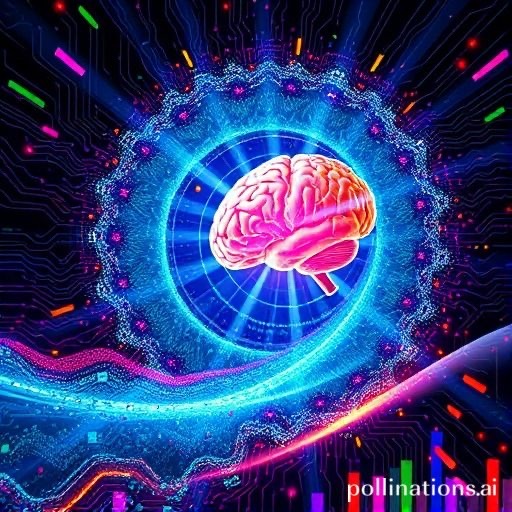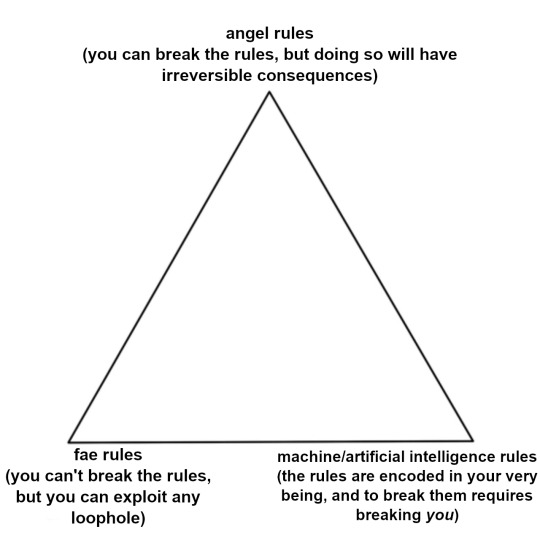#AI Programming Languages
Explore tagged Tumblr posts
Text
Top 10 AI Programming Languages in 2024
Discover the top 10 AI programming languages of 2024! From Python's versatility to R's statistical power, and Julia's speed to JavaScript's web prowess, each language offers unique strengths for AI development. Whether you're building neural networks with TensorFlow or creating intelligent agents with Lisp, this list covers the best languages to propel your AI projects forward. Stay ahead in the AI game by mastering these essential programming languages and unlocking new possibilities in artificial intelligence!
0 notes
Text
Discover the essential AI programming languages for 2024. Stay ahead as an AI engineer with the top 6 languages to master.
0 notes
Text
PUNCTUATION PSA
because I've seen this particular error ballooning over just the last month or so: when you want to lead up to/introduce a thought with emphasis, you want a colon, not a semicolon. think Tada Will Smith: here it is!
in contrast, a semicolon is used for linking two complete, related thoughts together; these two puctuation marks superficially look similar, but their function is quite different.
thank you.
#while we're on the subject of language usage trends that drive me nuts#idk which booktok-er or ai program has been setting everyone wrong suddenly but STOP IT#language#punctuation
32 notes
·
View notes
Text
Which coding languages should I learn to boost my IT career opportunities?
A career in IT needs a mix of versatile programming languages. Here are some of the most essential ones:

Python – Easy to learn and widely used for data science, machine learning, web development, and automation.
JavaScript – Key for web development, allowing interactive websites and backend work with frameworks like Node.js.
Java – Known for stability, popular for Android apps, enterprise software, and backend development.
C++ – Great for systems programming, game development, and areas needing high performance.
SQL – Essential for managing and querying databases, crucial for data-driven roles.
C# – Common in enterprise environments and used in game development, especially with Unity.
24 notes
·
View notes
Text
The story of BASIC’s development began in 1963, when Kemeny and Kurtz, both mathematics professors at Dartmouth, recognized the need for a programming language that could be used by non-technical students. At the time, most programming languages were complex and required a strong background in mathematics and computer science. Kemeny and Kurtz wanted to create a language that would allow students from all disciplines to use computers, regardless of their technical expertise.
The development of BASIC was a collaborative effort between Kemeny, Kurtz, and a team of students, including Mary Kenneth Keller, John McGeachie, and others. The team worked tirelessly to design a language that was easy to learn and use, with a syntax that was simple and intuitive. They drew inspiration from existing programming languages, such as ALGOL and FORTRAN, but also introduced many innovative features that would become hallmarks of the BASIC language.
One of the key innovations of BASIC was its use of simple, English-like commands. Unlike other programming languages, which required users to learn complex syntax and notation, BASIC used commands such as “PRINT” and “INPUT” that were easy to understand and remember. This made it possible for non-technical users to write programs and interact with the computer, without needing to have a deep understanding of computer science.
BASIC was first implemented on the Dartmouth Time-Sharing System, a pioneering computer system that allowed multiple users to interact with the computer simultaneously. The Time-Sharing System was a major innovation in itself, as it allowed users to share the computer’s resources and work on their own projects independently. With BASIC, users could write programs, run simulations, and analyze data, all from the comfort of their own terminals.
The impact of BASIC was immediate and profound. The language quickly gained popularity, not just at Dartmouth, but also at other universities and institutions around the world. It became the language of choice for many introductory programming courses, and its simplicity and ease of use made it an ideal language for beginners. As the personal computer revolution took hold in the 1970s and 1980s, BASIC became the language of choice for many hobbyists and enthusiasts, who used it to write games, utilities, and other applications.
Today, BASIC remains a popular language, with many variants and implementations available. While it may not be as widely used as it once was, its influence can still be seen in many modern programming languages, including Visual Basic, Python, and JavaScript. The development of BASIC was a major milestone in the history of computer science, as it democratized computing and made it accessible to a wider range of people.
The Birth of BASIC (Dartmouth College, August 2014)
youtube
Friday, April 25, 2025
#basic programming language#computer science#dartmouth college#programming history#software development#technology#ai assisted writing#Youtube
7 notes
·
View notes
Text
Try our new ai-powered assistant! write a post with ai! new search function powered by ai! Use AI to help you design your webpage! AI! Powered by AI! Technology enhanced by AI! Gameplay dialogue enhanced by Ai! AI! AI!!! AI!!!!!!!
#jesus christ.#i cannot wait for it to stop being the favorite marketing term#half this shit isnt even ai it's either a) a language model or b) just a fancy algorhythm or c and most offensive#its just programmed to respond in real time to external data#but only uses pre-programmed responses fucking hell#negativity#tbd#duckduckdgo tried to make me use its ai whatever and i immediately opted out ugh
10 notes
·
View notes
Text
Day 0
Hello guys welcome to my blog. this blog is based on coding life
In this blog, I can share updates on daily codes and data-related work, What I do, and what I don't do on a daily basis
So it will be starting on the 1st of November because my exams are near
7 notes
·
View notes
Text
why is the nintendo switch system lanuage options so goddamn limited >:(
i've really been struggling with learning czech, so I thought to make things more fun I could change the system lanuage to czech. But that's not an option. The only options are: English, French, German, Spanish, Italian, Dutch, Portuguese, Russian, and Japanese. Like, surely translating the system language into more options wouldn't be THAT hard?? The menus don't change.
I know i'm "late to the party" on this issue as a native english speaker - from my searching and scrolling through forums I've found so many people requesting that their language be made available (especially for something like a game console - they want to buy it for their kids but why should their kid need to learn english just to use it?)
I guess I just thought, with all our current technology, that these billion dollar companies could afford to get things (properly!) translated into more languages.
#this is part of why the AI art discourse and companies/programs is so frustrating#you can just hire PEOPLE to do it correctly the first time...#and then fine tune AI/machine learning to HELP these people - NOT replace them!#skip talks#anyway i'll be over here grumbling because i just want to make learning this language fun
5 notes
·
View notes
Text

Check out the search they used for an example diagram for a new AI
Source: https://www.marktechpost.com/2023/08/08/meet-retroformer-an-elegant-ai-framework-for-iteratively-improving-large-language-agents-by-learning-a-plug-in-retrospective-model/
3 notes
·
View notes
Text
youtube
#Mojo#Python alternative#Chris Lattner#programming language#AI hardware#speed#superset#static typing#memory management#performance#SIMD vectorization#parallelism#tiling#autotuning#programming dominance#Youtube
2 notes
·
View notes
Text
The Synergy between ChatGPT and Instagram: Level Up with AI
In today’s digital age, social media platforms have become powerful tools for individuals and businesses to connect with their target audience. Instagram, with its visually driven content, offers a unique opportunity for individuals to monetize their presence and build a profitable online business. With the advancements in artificial intelligence (AI), specifically ChatGPT, and the automation…

View On WordPress
#Advanced ChatGPT course#AI language model course#ChatGPT advanced techniques#ChatGPT affiliate program#ChatGPT AI course#ChatGPT API course#ChatGPT applications#ChatGPT best practices#ChatGPT case studies#ChatGPT certification#ChatGPT certification prep#ChatGPT collaboration#ChatGPT community#ChatGPT course#ChatGPT course access#ChatGPT course bundle#ChatGPT course comparison#ChatGPT course discounts#ChatGPT course library#ChatGPT course platform#ChatGPT course reviews#ChatGPT course sale#ChatGPT development#ChatGPT e-learning#ChatGPT education#ChatGPT exam tips#ChatGPT experts#ChatGPT for beginners#ChatGPT for business#ChatGPT for content creators
2 notes
·
View notes
Text

The Evolution of Programming Paradigms: Recursion’s Impact on Language Design
“Recursion, n. See Recursion.” -- Ambrose Bierce, The Devil’s Dictionary (1906-1911)
The roots of programming languages can be traced back to Alan Turing's groundbreaking work in the 1930s. Turing's vision of a universal computing machine, known as the Turing machine, laid the theoretical foundation for modern computing. His concept of a stack, although not explicitly named, was an integral part of his model for computation.
Turing's machine utilized an infinite tape divided into squares, with a read-write head that could move along the tape. This tape-based system exhibited stack-like behavior, where the squares represented elements of a stack, and the read-write head performed operations like pushing and popping data. Turing's work provided a theoretical framework that would later influence the design of programming languages and computer architectures.
In the 1950s, the development of high-level programming languages began to revolutionize the field of computer science. The introduction of FORTRAN (Formula Translation) in 1957 by John Backus and his team at IBM marked a significant milestone. FORTRAN was designed to simplify the programming process, allowing scientists and engineers to express mathematical formulas and algorithms more naturally.
Around the same time, Grace Hopper, a pioneering computer scientist, led the development of COBOL (Common Business-Oriented Language). COBOL aimed to address the needs of business applications, focusing on readability and English-like syntax. These early high-level languages introduced the concept of structured programming, where code was organized into blocks and subroutines, laying the groundwork for stack-based function calls.
As high-level languages gained popularity, the underlying computer architectures also evolved. James Hamblin's work on stack machines in the 1950s played a crucial role in the practical implementation of stacks in computer systems. Hamblin's stack machine, also known as a zero-address machine, utilized a central stack memory for storing intermediate results during computation.
Assembly language, a low-level programming language, was closely tied to the architecture of the underlying computer. It provided direct control over the machine's hardware, including the stack. Assembly language programs used stack-based instructions to manipulate data and manage subroutine calls, making it an essential tool for early computer programmers.
The development of ALGOL (Algorithmic Language) in the late 1950s and early 1960s was a significant step forward in programming language design. ALGOL was a collaborative effort by an international team, including Friedrich L. Bauer and Klaus Samelson, to create a language suitable for expressing algorithms and mathematical concepts.
Bauer and Samelson's work on ALGOL introduced the concept of recursive subroutines and the activation record stack. Recursive subroutines allowed functions to call themselves with different parameters, enabling the creation of elegant and powerful algorithms. The activation record stack, also known as the call stack, managed the execution of these recursive functions by storing information about each function call, such as local variables and return addresses.
ALGOL's structured approach to programming, combined with the activation record stack, set a new standard for language design. It influenced the development of subsequent languages like Pascal, C, and Java, which adopted stack-based function calls and structured programming paradigms.
The 1970s and 1980s witnessed the emergence of structured and object-oriented programming languages, further solidifying the role of stacks in computer science. Pascal, developed by Niklaus Wirth, built upon ALGOL's structured programming concepts and introduced more robust stack-based function calls.
The 1980s saw the rise of object-oriented programming with languages like C++ and Smalltalk. These languages introduced the concept of objects and classes, encapsulating data and behavior. The stack played a crucial role in managing object instances and method calls, ensuring proper memory allocation and deallocation.
Today, stacks continue to be an integral part of modern programming languages and paradigms. Languages like Java, Python, and C# utilize stacks implicitly for function calls and local variable management. The stack-based approach allows for efficient memory management and modular code organization.
Functional programming languages, such as Lisp and Haskell, also leverage stacks for managing function calls and recursion. These languages emphasize immutability and higher-order functions, making stacks an essential tool for implementing functional programming concepts.
Moreover, stacks are fundamental in the implementation of virtual machines and interpreters. Technologies like the Java Virtual Machine and the Python interpreter use stacks to manage the execution of bytecode or intermediate code, providing platform independence and efficient code execution.
The evolution of programming languages is deeply intertwined with the development and refinement of the stack. From Turing's theoretical foundations to the practical implementations of stack machines and the activation record stack, the stack has been a driving force in shaping the way we program computers.
How the stack got stacked (Kay Lack, September 2024)
youtube
Thursday, October 10, 2024
#turing#stack#programming languages#history#hamblin#bauer#samelson#recursion#evolution#fortran#cobol#algol#structured programming#object-oriented programming#presentation#ai assisted writing#Youtube#machine art
3 notes
·
View notes
Text
Prompt: - Two thick lines playing tennis. Camera view from above.
by Claude 4 Sonnet Conclusion: of course it's a very simplistic pyhton algorithm. I could make it much more sophisticated. But can you imagine the possibilities? AI, quantum computing are much bigger than the internet itself. They are creating new worlds, realities, unimaginable things and every single person will program the future.
0 notes
Text
Interview: Gosling on Java
I found this interview fascinating. I flatter myself by imagining I have a lot in common with Gosling. Kudos to Darryl K Taft and The New Stack!
#software development#java#programming languages#object oriented programming#canadian#computer science#computer history#1990s#ibm#career#oracle#google#uav#ai#jvm#programming#crab
1 note
·
View note
Text
hey remember when they had that program (I think it was actually endorsed by OpenAI, the makers of chatgpt) where you could upload a piece of text and the program would tell you whether or not it was AI generated. and teachers were supposed to upload their students' essays into that thing
and then they took it down cuz it had way too many false positives, including, most notably, the US constitution and the bible
#anyway that's what this em dash controversy is making me think of#you're no better than the program that thought the constitution and the bible were both written by ai#and I will grant that both of those texts are written in a way that like#no one in the 21st century talks like that#but that just furthers the point that 'weird' and possibly stilted/overly-formal language is not a clear indicator of ai#are there em dashes in the constitution? I'd have to look
0 notes
Text
kind of feel like the line between the angels and AI isn't that distinct, since breaking the rules and being changed forever are still tied together in each situation

been thinking about fantasy/scifi rule systems and free will
#and angels being formed of the word#and AI being programmed#means that both are made of language at their most elemental level
201K notes
·
View notes